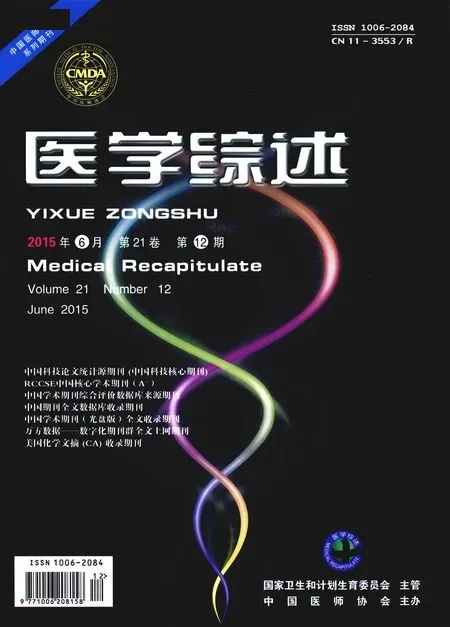造血干细胞移植治疗原发性免疫缺陷病
陈丽白(综述),吴学东(审校)
(南方医科大学南方医院儿科,广州 510515)
造血干细胞移植治疗原发性免疫缺陷病
陈丽白△(综述),吴学东※(审校)
(南方医科大学南方医院儿科,广州 510515)
原发性免疫缺陷病是不同基因缺陷引起免疫细胞或免疫分子缺陷,导致机体免疫功能低下的疾病。造血干细胞移植(HSCT)是目前治疗原发性免疫缺陷病的有效方法。HSCT来源不同,疗效、预后存在不同的特点。该文就不同来源HSCT治疗严重联合免疫缺陷病、维斯科特-奥尔德里奇综合征、高IgM综合征、慢性肉芽肿病这四种原发性免疫缺陷病的进展进行综述。
造血干细胞移植;严重联合免疫缺陷病;维斯科特-奥尔德里奇综合征;高IgM综合征;慢性肉芽肿病
原发性免疫缺陷病(primary immunodeficiency disease,PID)共同临床表现为反复感染、易患自身免疫性疾病和恶性肿瘤。造血干细胞移植(hematopoietic stem cell transplantation,HSCT)是治愈多数细胞免疫缺陷疾病的有效方法。造血干细胞根据来源分为骨髓、脐带血和外周血,供者来源有人类白细胞抗原(human leukocyte antigen,HLA)相合同胞供者 (HLA-matched sibling donor,MSD)、HLA相合亲缘供者 (HLA-matched related donor,MRD),HLA相合非亲缘供者 (HLA-matched unrelated donor,MUD)、HLA不全相合亲缘供者(HLA-mismatched related donor,MMRD)以及HLA半相合供者(haploidentical donor,HID)。不同来源造血干细胞的移植在治疗效果、并发症、远期预后方面存在不同的特点。现就HSCT治疗PID的研究进展予以综述。
1 HSCT治疗严重联合免疫缺陷病
严重联合免疫缺陷病 (severe combined immunodeficiency disease,SCID)是由于分子缺陷严重影响到T淋巴细胞、B淋巴细胞或自然杀伤(natural killer,NK) 细胞的数量和功能,导致体液免疫、细胞免疫同时存在严重缺陷,是联合免疫缺陷病中最严重的类型。患儿出生后无症状期的时间很短,自然生存期通常只有1~2岁,故存在SCID患儿需急诊移植的概念。
1.1 SCID的类型对 HSCT 预后的影响 不同类型的SCID患儿移植后的疗效存在差异。如T-B-NK-、T-B+NK-SCID由于T细胞、NK细胞缺如,移植过程中没有宿主抗移植物作用,可不经预处理,但易引起B细胞不能植入,CD34细胞分选有助于克服移植排斥,但可能影响B细胞免疫重建。T-B-NK+SCID患儿NK细胞易排斥移植物而造成植入失败,因此移植前需接受一定强度的免疫抑制预处理。T-B-SCID患儿生存率不及T-B+SCID患儿,预处理方案完善显著提高了B-患儿的近期生存率[1-2]。SCID中唯一能够采用替代治疗的是腺苷脱氨酶缺乏症。Hassan等[3]研究显示,腺苷脱氨酶缺乏症患儿接受MSD、MUD、HID、MMRD的总体生存率分别为86%、67%、43%、29%,提示在缺乏MSD供体的情况下, 其他供者来源的HSCT治疗效果并不优于酶替代治疗,且移植后患儿中枢神经系统并发症如智力发育迟缓、运动发育障碍、听力障碍发生率高。
1.2 MSD移植治疗SCID 大部分SCID患者完全没有排斥移植物的 T淋巴细胞, 所以即使不进行预处理也能保证移植物的植入,避免了清髓药物带来的毒性反应。但对于某些亚型, 如网状细胞发育不全,常需要联合使用清髓和免疫抑制剂进行预处理,以确保迅速有效的植入。Gennery等[4]总结了欧洲699例HSCT治疗SCID结果,MSD、MMRD、MUD三年生存率分别为90%、66%、69%。Railey等[5]报道16例MSD移植(1982~2008年)的长期生存率为100%。综上所述,现MSD移植治疗SCID生存率可达到90%以上,远期移植物抗宿主疾病、自身免疫性疾病、机会性感染发生率低,多数患者能拥有长期稳定的免疫重建,生存率较高,是SCID患者最理想的治疗方法。
1.3 MUD移植治疗SCID 随着移植物抗宿主疾病预防方案的不断完善, MUD的长期生存率已接近MSD。Grunebaum等[6]报道MUD、MMRD骨髓移植患者长期生存率分别为80.5%、52.5%,T淋巴细胞功能的免疫重建率分别为94.7%、61.1%,但急性移植物抗宿主疾病发生率分别为73.1%、45.0%,间质性肺炎发生率分别为35.0%、7.3%。Gaspar等[2]报道MUD、HID移植患者长期生存率分别为73%、54%,如果患者健康状况稳定并且积极预防感染,MUD可作为优先考虑的供者来源。
1.4 HID移植治疗SCID 并非每例患者都能找到HLA相合供者,有研究证明,无关HLA不全相合供者并不优于HID供者移植的效果,且推迟SCID患者移植时间将增加感染的风险[7]。Railey等[5]报道145例HID移植治疗SCID,患者均未接受预处理和移植物抗宿主疾病预防,其中28例患者进行了多次移植,总体生存率为75%,移植后均未出现移植物抗宿主疾病,但58%的患者需移植后仍需静脉输注丙种球蛋白替代治疗,原因可能与SCID 基因缺陷类型有关,白细胞介素7受体α链缺陷、重组激活基因缺陷、X连锁SCID移植后需要静脉输注丙种球蛋白的比例分别为27%、83%、72%。Cipe等[8]报道15例HID移植治疗SCID,移植中位年龄4个月,平均CD34+输注数30.6×106/kg,67%的患者获得了T淋巴细胞功能的免疫重建。
1.5 脐血移植治疗SCID 近年,脐血已成为有效的造血干细胞的来源, Fernandes等[9]回顾性比较152例MMRD和59例无关脐血移植治疗SCID,中位随访时间83个月;T淋巴细胞功能的免疫重建及5年总体生存率两者的差异无统计学意义,但大多数MMRD需多次移植。脐带血移植可以允许存在1~2个HLA 位点不相合,但是2个以上HLA位点不合的生存率仅为35%,故2个以上HLA位点不合时应避免行脐血移植;Ⅱ~Ⅳ度急性移植物抗宿主疾病发生率分别为34%、22%,慢性移植物抗宿主病发生率分别为22%、10%,无关脐血移植组移植物抗宿主病发生率高。
2 HSCT治疗维斯科特-奥尔德里奇综合征
维斯科特-奥尔德里奇综合征(Wiskott-Aldrich syndrome, WAS)又称湿疹-血小板减少性紫癜-免疫缺陷综合征, 临床表现以血小板减少伴小血小板、湿疹、免疫缺陷三联征及易患自身免疫性疾病和恶性肿瘤为特点,是一种罕见的X-连锁隐性遗传性免疫缺陷病。
2.1 MSD、MMRD移植治疗 WAS MSD移植治疗WAS无病生存率可达80%以上。2001年,Filipovich等[10]总结170例WAS骨髓移植结果,包括55例MSD,移植后的5年存活率为87%(74%~93%)。Moratto等[11]报道194例接受HSCT的WAS患者,总生存率为84.0%,总体中位生存时间为76.8个月;2000年前后5年生存率、8年生存率分别为74.9%、73.4%和89.1%、83.3%;特别是MMRD组生存率从52.2% 上升为91.7%,移植排斥率为7%,22例患者观察到Ⅱ度以上急性移植物抗宿主疾病,慢性移植物抗宿主疾病的发生率为11.3%、5.7%。
2.2 MUD移植治疗 WAS MUD移植的效果稍差于MSD移植。西班牙方面总结了13例病情严重的WAS患者HSCT后长期疗效, MUD 组有4例患者发生Ⅱ度以上的急性移植物抗宿主疾病,2例死于Ⅳ度急性移植物抗宿主疾病和器官衰竭,总生存率为69.2%[12]。欧洲移植合作组报道96例患者HSCT治疗WAS,总生存率97%,总体7年无病生存率为75%,MSD的无病生存率为88%(78%~98%),移植2年后,7%的患者出现了慢性移植物抗宿主疾病[13]。Lee等[14]报道中国MSD 2例、MUD 2例、MMRD 5例,总生存率、无病生存率均为100%,自身免疫性疾病在MSD、MUD、MMRD发生率分别为11%、28%、26%。
2.3 HID移植治疗 WAS 现阶段半相合移植的结果还不是十分令人满意。Friedrich等[15]分析了9例MSD、15例MUD、15例HID移植,总生存率为90%,其中源自父母HID移植生存率只有50%,MUD组有2例患者死于慢性移植物抗宿主疾病及间质性肺炎,HID组8例患者死于感染、移植排斥、免疫重建延迟及慢性移植物抗宿主疾病。Mahlaoui等[16]报道,22例HSCT治疗伴自身免疫性疾病或恶性疾病的WAS,其中1例MSD、1例MRD、12例HID、7例MUD、1例MMRD,中位随访时间7年,17例存活,2例HID进行了二次移植,后遗症包括4例患者出现支气管扩张、慢性肺疾病,5例出现癫痫,7例存在双侧痉挛性瘫痪和单侧血管炎引起的失明。
2.4 脐血移植治疗WAS Ochs等[17]报道65例WAS 患儿接受无关脐血移植与同期113例接受 MUD骨髓移植的WAS患儿移植结果的差异无统计学意义。Morio等[18]报道23例WAS患儿接受无关脐血移植,患儿平均年龄14个月,HLA全相合或者1个位点不合,移植前主要采用白消安/环磷酰胺清髓预处理方案,环孢素预防移植物抗宿主疾病,5年生存率为82%。
3 HSCT治疗高IgM 综合征
高IgM综合征又称为Ig类别转换重组缺陷,典型表现为IgG和 IgA水平降低或缺乏,IgM水平升高或正常,B淋巴细胞数正常。Gennery等[19]报道了欧洲8个国家的38例接受骨髓移植的高IgM综合征病例,14例MSD移植、22例MUD移植和2例父母供者移植,主要采用白消安/环磷酰胺[加或不加抗胸腺细胞球蛋白(anti-thyroglobulin antibodies,ATG)]或氟达拉滨/美法仑/ATG预处理方案,移植后26例(68%) 存活,仅4例自体免疫重建成功,12例死亡,总体生存率为58%。死亡原因主要是严重的移植物抗宿主疾病、感染相关并发症,6例患者出现了严重的隐孢子虫感染和肝脏损害。移植前有肺部疾病和HLA不匹配、无关供者移植是导致移植存活率低的主要原因。Jasinska等[20]报道1例HID移植治愈X-连锁高IgM综合征(CD40LGY172C基因突变),证明半相合外周造血干细胞也可以有效地纠正X-连锁高IgM综合征缺陷。
脐血移植治疗IgM 综合征的资料不多。Ziegner等[21]报道了第1例脐血移植治疗X-连锁高IgM综合征。采用白消安/环磷酰胺/ATG清髓预处理方案和环孢素/甲泼尼龙预防移植物抗宿主疾病,随访2年,CD40L基因恢复正常稳定表达。其后陆续有脐血移植成功治愈高IgM综合征的报道,长期疗效有待观察[2,22]。
4 HSCT治疗慢性肉芽肿病
慢性肉芽肿病(chronic granulomatous disease,CGD)是由于基因突变引起吞噬细胞还原型辅酶氧化酶复合物缺陷,导致吞噬细胞功能障碍。主要特征为反复严重的细菌和真菌感染炎症反应失调所致肉芽肿形成以及其他炎症性疾病。从1973年第1例骨髓移植成功治疗CGD后,HSCT显示出对于传统治疗的巨大优势。Martinez等[23]报道11例移植治疗慢性肉芽肿病,9例男性为X-连锁CGD,2例常染色体隐性CGD,移植后MRD及MUD中性粒细胞恢复中位时间分别为16 d和18 d,仅4例出现Ⅰ度急性移植物抗宿主病,移植时间1~8年,均存活。Åhlin等[24]报道6例MRD,5例MUD,3例脐血移植,大多数采用白消安/环磷酰胺(用或不用ATG、阿仑单抗),1例脐血移植失败,2例患者出现Ⅱ度急性移植物抗宿主疾病,1例患者出现Ⅱ度急性移植物抗宿主疾病,随访时间1~16年,移植成功的13例患者均取得良好的无病生存。欧洲[25]报道了使用白消安、氟达拉滨基础上的非清髓预处理取得了良好的效果,白消安目标剂量45~65 mg/(L·h),21例MRD和35例MUD,中性粒细胞、血小板植入的中位时间分别为19、21 d。中位随访时间21个月,总生存率为93%,无事件生存率为89%。Kang等[26]报道11例HSCT治疗慢性肉芽肿病,其中9例MUD、1例无关脐血、1例MUD移植,结果无关脐血移植失败,2例分别发生Ⅰ度、Ⅱ度皮肤移植物抗宿主疾病,1例MUD死于肾衰竭,总生存率达到91%。相关文献报道无严重感染的患儿脐血移植或脐血联合骨髓移植也取得了不错的效果[27-28]。
5 小 结
HSCT可重建造血及免疫功能,已成为根治原发性免疫缺陷病最有效的方法。一般来说,移植的优先顺序为:MSD,MUD,无关脐血移植,MMRD,HID。在具体的临床实践应用中,需根据不同疾病、选择不同的预处理方案,进一步减少移植物抗宿主病的影响,加快免疫重建,减少移植相关并发症,以获得更好的预后及生存率。
[1] Horn B,Cowan MJ.Unresolved issues in hematopoietic stem cell transplantation for severe combined immunodeficiency:need for safer conditioning and reduced late effects[J].J Allergy Clin Immunol,2013,131(5):1306-1311.
[2] Gaspar HB,Qasim W,Davies EG,etal.How I treat severe combined immunodeficiency[J].Blood,2013,122(23):3749-3758.
[3] Hassan A,Booth C,Brightwell A,etal.Outcome of haematopoietic stem cell transplantation for adenosine deaminase deficient severe combined immunodeficiency[J].Blood,2012,120(17):3615-
3624.
[4] Gennery AR,Slatter MA,Grandin L,etal.Transplantation of hematopoietic stem cells and long term survival for primary immunodeficiencies in Europe:entering a new century,do we do better[J].J Allergy Clin Immunol,2010,126(3):602-610.
[5] Railey MD,Lokhnygina Y,Buckley RH,etal.Long-term clinical outcome of patients with severe combined immunodeficiency who received related donor bone marrow transplants without pretransplant chemotherapy or post-transplant GVHD prophylaxis[J].J Pediatr,2009,155(6):834-840.
[6] Grunebaum E,Mazzolari E,Porta F,etal.Bone marrow transplantation for severe combined immune deficiency[J].JAMA,2006,295(5):508-518.
[7] Pai SY,Logan BR,Griffith LM,etal.Transplantation outcomes for severe combined immunodeficiency,2000-2009[J].N Engl J Med,2014,371(5):434-446.
[8] Cipe FE,Dogu F,Aytekin C,etal.HLA-haploidentical transplantations for primary immunodeficiencies:a single-center experience[J].Pediatr Transplant,2012,16(5):451-457.
[9] Fernandes JF,Rocha V,Labopin M,etal.Eurocord and Inborn Errors Working Party of European Group for Blood and Marrow Transplantation,Transplantation in patients with SCID:mismatched related stem cells or unrelated cord blood?[J].Blood,2012,119(12):2949-2955.
[10] Filipovich AH,Stone JV,Tomany SC,etal.Impact of donor type on outcome of bone marrow trans-plantation for Wiskott-Aldrich syndrome:collaborative study of the International Bone Marrow[J].Blood,2001,97(6):1598-1603.
[11] Moratto D,Giliani S,Bonfim C,etal.Long-term outcome and lineage-specific chimerism in 194 patients with Wiskott-Aldrich syndrome treated by hematopoietic cell transplantation in the period 1980-2009:an international collaborative study[J].Blood,2011,118(6):1675-1684.
[13] Ozsahin H,Cavazzana-Calvo M,Notarangelo LD,etal.Long-term outcome following hematopoietic stem cell transplantation in Wiskott-Aldrich syndrome:collaborative study of the European Society for Immunodeficiencies and European Group for Blood and Marrow Transplantation[J].Blood,2008,111(1):439-445.
[14] Lee PP,Chen TX,Jiang LP,etal.Clinical and molecular characteristics of 35 Chinese children with Wiskott-Aldrich syndrom[J].J Clin Immunol,2009,29(4):490-500.
[15] Friedrich W,Schutz C,Schulz A,etal.Results and long-term outcome in 39 patients with Wiskott-Aldrich syndrome trans-planted from HLA-matched and mismatcheddonors[J].Immunol Res,2009,44(1):18-24.
[16] Mahlaoui N,Pellier I,Mignot C,etal.Characteristics and outcome of early-onset,severe forms of Wiskott-Aldrich syndrome[J].Blood,2013,121(9):1510-1516.
[17] Ochs HD,Filipovich AH,Veys P,etal.Wiskott-Aldrich syndrome:diagnosis,clinical and laboratory manifestations,and treatment[J].Biol Blood Marrow Transplant,2009,15(1):84-90.
[18] Morio T,Atsuta Y,Tomizawa D,etal.Outcome of unrelated umbilical cord blood transplantation in 88 patients with primary immunodeficiency in Japan[J].Br J Haematol,2011,154(3):363-372.
[19] Gennery AR,Khawaja K,Veys P,etal.Treatment of CD40ligand deficiency by hematopoietic stem cell transplantation:a survey of the European experience,1993-2002[J].Blood,2004,103(3):1152-1157.
[20] Jasinska A,Kalwak K,Trelinska J,etal.Successful haploidentical PBSCT with subsequent T-cell addbacks in a boy with HyperIgM syndrome presenting as severe congenital neutropenia[J].Pediatr Transplant,2013,17(1):37-40.
[21] Ziegner UH,Ochs HD,Schanen C,etal.Unrelated umbilical cord stem cell transplantation for X-linked immunodeficiencies[J].J Pediatr,2001,138(4):570-573.
[22] Wahadneh AM,Bin Dahman HA,Abu Shukear ME,etal.Mismatched related hematopoietic stem cell transplantation in primary immunodeficiency[J].Saudi J Kidney Dis Transpl,2013,24(6):1137-1143.
[23] Martinez C,Shah S,Shearer WT,etal.Excellent survival after sibling or unrelated donor stem cell transplantation for chronic granulomatous disease[J].J Allergy Clin Immunol,2012,129(1):176-183.
[24] Åhlin A,Fugeläng J,de Boer M,etal.Chronic granulomatous disease-haematopoietic stem cell transplantation versus conventional treatment[J].Acta Paediatr,2013,102(11):1087-1094.
[25] Güngör T,Teira P,Slatter M,et al.Reduced-intensity conditioning and HLA-matched haemopoietic stem-cell transplantation in patients with chronic granulomatous disease:a prospective multicentre study[J].Lancet,2014,383(9915):436-448.
[26] Kang EM,Marciano BE,DeRavin S,etal.Chronic granulomatous disease:overview and hematopoietic stem cell transplantation[J].J Allergy Clin Immunol,2011,127(6):1319-1326.
[27] Cole T,Pearce MS,Cant AJ,etal.Clinical outcome in children with chronic granulomatous disease managed conservatively or with hematopoietic stem cell transplantation[J].J Allergy Clin Immunol,2013,132(5):1150-1155.
[28] Lin CJ,Wang SC,Ku CL,etal.Successful Unrelated Cord Blood Stem Cell Transplantation in an X-linked Chronic Granulomatous Disease Patient with Disseminated BCG-induced Infection[J/OL].Pediatr Neonatol,2013[2014-01-10].http://www.ncbi.nlm.nih.gov/pubmed/?term=Successful+Unrelated+Cord+Blood+Stem+Cell+Transplantation+in+an+X-linked+Chronic+[published online ahead of print May 13,2013].
Hematopoietic Stem Cell Transplantation for Primary Immunodeficiency Disease
CHENLi-bai,WUXue-dong.
(DepartmentofPediatrics,NanfangHospital,SouthernMedicalUniversity,Guangzhou510515,China)
Primary immunodeficiency diseases are a group of inherited disorders with genetic defects in immune cells or molecules,which result in weakened immunity.Hematopoietic stem cell transplantation(HSCT) is an effective therapy currently.There are different sources of HSCT,which have different characteristics in the aspect of therapeutic effect and prognosis.Here is to make a review of the progress of HSCT treatment for the four primary immunodeficiency diseases of severe combined immunodeficiency disease,Wiskott-Aldridge syndrome,hyper-IgM syndrome,and chronic granulomatous disease.
Hematopoietic stem cell transplantation; Severe combined immunodeficiency disease; Wiskott-Aldrich syndrome; Hyper-IgM syndrome; Chronic granulomatous disease
国家自然科学基金(81270632)
R593.2
A
1006-2084(2015)12-2117-04
10.3969/j.issn.1006-2084.2015.12.003
2014-06-16
2014-12-17 编辑:孙洪芳

